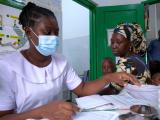Mar 2, 2011
Indonesia reports fatal H5N1 case
A 26-year-old Indonesian woman has died of H5N1 avian influenza, becoming the country's official first H5N1 case this year, the World Health Organization (WHO) said today. The woman, from West Java province, became ill Jan 31, was hospitalized Feb 3, and died Feb 8 despite oseltamivir (Tamiflu) treatment. She had bought poultry meat as well as chickens at a live market that were slaughtered and prepared on site before she brought them home. Laboratory tests confirmed the diagnosis, according to Indonesia's Ministry of Health. Since 2005 Indonesia has reported 172 H5N1 cases, including 142 deaths, for a case-fatality rate of 83%. In both categories the nation leads the world, accounting for a third of the world's WHO-confirmed 526 H5N1 cases and almost half of its 311 deaths.
Mar 2 WHO notice
Moderate to severe flu pandemic could taint drinking water
Because of excretion of antiviral and antibiotic compounds from the body, a moderate to severe influenza pandemic could reduce wastewater treatment efficiency and thereby deteriorate drinking water quality, according to a study published today in Environmental Health Perspectives. A team of UK, US, Italian, and Dutch researchers coupled a global spatial epidemic model that simulates the quantities of antiviral and antibiotic drugs used during a flu pandemic of varying severity with a water-quality model applied to the River Thames in southern England. They used the combined results to predict environmental drug concentrations, then applied an additional model to assess environmental toxicity in wastewater treatment plants and rivers. The team concluded that a pandemic such as 2009 H1N1 would affect environmental drug levels negligibly. But they found that in a more severe pandemic, 80% to 100% of treatment plants would exceed the threshold for microbial growth inhibition, potentially reducing their capacity to treat wastewater. In addition, they predicted that 5% to 40% of the Thames would exceed key thresholds for environmental toxicity, which could then contaminate drinking water. The authors state, "Widespread drugs in the environment could hasten the generation of drug resistance."
Mar 2 press release on the study
IV peramivir well tolerated during H1N1 2009 pandemic
An analysis of all 41 US patients treated with the intravenous antiviral peramivir under an Emergency Investigational New Drug authorization during the 2009 H1N1 influenza pandemic revealed that the drug was well tolerated and most patients recovered. Researchers studied 20 adults and 11 children who received peramivir from April through October of 2009 after rapidly progressing, radiographically confirmed viral pneumonia with respiratory failure. All but one required mechanical ventilation. In most patients illness had progressed despite oseltamivir (Tamiflu) treatment. Peramivir was administered for 1 to 14 days, with a median of 10 days. The 14-day, 28-day, and 56-day survival rates were 76.7%, 66.7%, and 59.0%, respectively, and the authors report that the drug was generally well tolerated.
Mar 15 Clin Infect Dis abstract
Mar 15 editorial on the study
Mass dispensing of pandemic flu vaccine helped hone preparedness
Very positive feedback from the public plus numerous and valuable lessons learned followed New York City's largest real-world test to date of its plan for mass dispensing of prophylactic medication to residents. During November and December 2009, the city's Department of Health and Mental Hygiene provided H1N1 pandemic vaccine to residents at 58 points of dispensing (PODs), mainly in schools, over five weekends (10 days). A maximum of seven sites across the city were open each day—for 10 hours on Saturdays and 9 hours on Sundays. About 2,800 staff from 18 NYC agencies and more than 200 Medical Reserve Corps volunteers contributed more than 65,000 hours of labor and vaccinated nearly 50,000 people. Among the many lessons learned were the importance of organized labor support, of a carefully planned evaluation process, and of clearly communicated protocols and procedures at dispensing sites, including audiovisual equipment for just-in-time training. Before the 2009 flu pandemic, no more than five PODs had been open simultaneously in New York City. The findings underscore the importance of real-world testing of mass dispensing plans, in part because it increases the pool of trained POD staff.
Mar 1 Biosecurity and Bioterrororism article abstract
HIV patients still vulnerable after pandemic H1N1 vaccination
HIV patients are significantly less likely than non-HIV patients to generate and maintain protective antibody responses to 2009 H1N1 influenza vaccine, leaving them susceptible to infection, says a study published in Vaccine. The study involved 127 participants, 63 with HIV and 64 without HIV infection; patients ranged in age from 18 to 50 years, and 83% of the HIV-infected patients were receiving highly active anti-retroviral treatment (HAART). Antibody levels to the 2009 H1N1 strain were measured by hemagglutination-inhibition assay at day 0, day 28, and 6 months after a single dose of vaccine. Seroconversion was defined as a titer of 1:40 or more postvaccination in those with a prevaccination titer of 1:10 or less. The HIV patients were less likely than the non-HIV patients to show seroconversion at day 28 (54% vs 75%) or to have a durable response at 6 months (28% vs 56%). In addition, geometric mean titers (GMTs) at 6 months were significantly lower among the HIV patients; younger age and receipt of HAART were associated with higher GMTs. The authors conclude that more immunogenic vaccines against influenza, in addition to HAART, are needed in this population.
Mar 1 Vaccine article (uncorrected proof)
Drug to combat diarrhea gets FDA OK for phase 1 trials
In what it calls a milestone in the fight against cholera, the Institute for OneWorld Health (iOWH) yesterday announced that it received US Food and Drug Administration (FDA) approval to begin phase 1 trials for iOWH032, a drug to treat secretory diarrhea. The iOWH said in a news release, "This is the first submission of an Investigational New Drug application for a completely new chemical entity by a non-profit of this size to receive such rapid FDA clearance, and it could be the first synthetic drug of its kind for diarrheal diseases." The new drug, whose development was funded by the Bill & Melinda Gates Foundation, reduces fluid loss and is designed to be used in conjunction with oral rehydration therapy to combat dehydration. "It is hard to overstate the need for this kind of medicine," said iOWH CEO Richard Chin, MD. "Diarrheal diseases—such as cholera—kill more children in developing countries than AIDS, tuberculosis, and malaria combined." Chin said the institute, based in San Francisco, hopes to begin phase 1 human trials next month.
Mar 1 iOWH news release


















